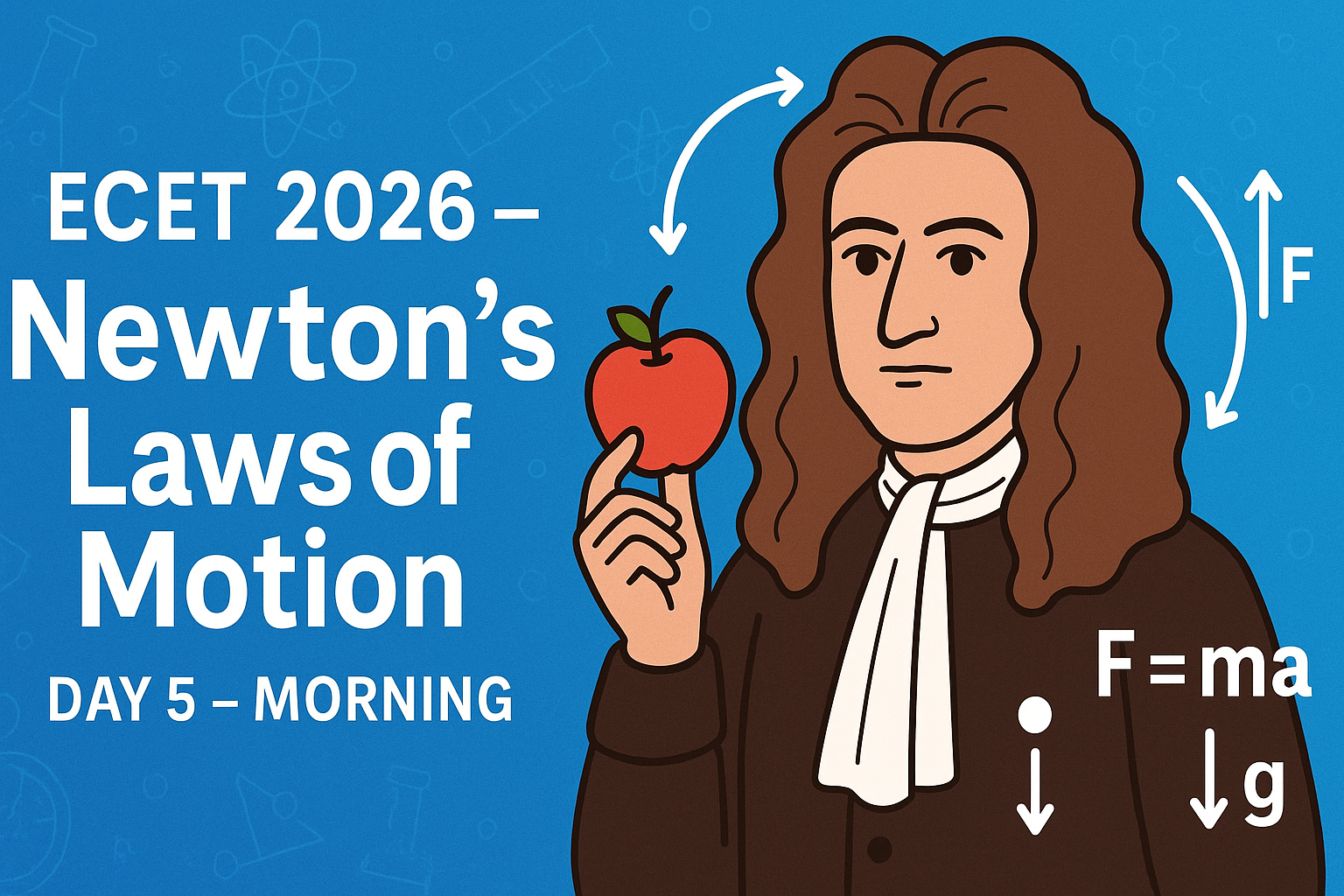
For ECET 2026 CSE aspirants, scoring high in the Physics section is a game-changer—and one of the most fundamental and repeatedly asked topics is Newton’s Laws of Motion. Whether you’re answering conceptual MCQs or solving numericals, understanding these three laws gives you a strong foundation in mechanics. Let’s break it down with clear concept notes, followed by 10 targeted MCQs with answers and detailed explanations.
📘 Concept Notes – Newton’s Laws of Motion
⚙️ 1st Law – Law of Inertia:
“An object remains at rest or in uniform motion unless acted upon by an external force.”
- Explains inertia (resistance to change in motion).
- Example: A stationary object stays still until pushed.
🧲 2nd Law – F = ma:
“The rate of change of momentum is directly proportional to the applied force and occurs in the direction of the force.”
- Formula: F = m × a (Force = mass × acceleration)
- This law quantifies force.
- More force → more acceleration (if mass is constant).
💥 3rd Law – Action & Reaction:
“For every action, there is an equal and opposite reaction.”
- Forces always occur in pairs.
- Example: When you push on a wall, it pushes back.
🧠 Key Terms to Remember:
- Inertia: Tendency of a body to resist motion change.
- Force: Any push or pull acting on a body.
- Momentum (p): p = m × v
- Units:
- Force = Newton (N)
- Mass = kg
- Acceleration = m/s²
🔟 10 Most Expected MCQs – ECET 2026 [Newton’s Laws of Motion]
Q1. Newton’s First Law is also known as:
A) Law of force
B) Law of inertia
C) Law of energy
D) Law of gravity
Q2. What is the formula given by Newton’s Second Law?
A) F = mv
B) F = m + a
C) F = ma
D) F = m/a
Q3. Which law explains why a gun recoils backward when fired?
A) First Law
B) Second Law
C) Third Law
D) None
Q4. A body continues to move in a straight line with constant speed due to:
A) Gravity
B) Friction
C) Inertia
D) Acceleration
Q5. Unit of Force in SI system is:
A) Dyne
B) Kilogram
C) Joule
D) Newton
Q6. A truck has more inertia than a car because:
A) It moves faster
B) It’s bigger in size
C) It has more mass
D) It’s made of metal
Q7. Newton’s Second Law is related to:
A) Inertia
B) Acceleration
C) Reaction force
D) Circular motion
Q8. Action and reaction forces always:
A) Act on same body
B) Act on different bodies
C) Cancel each other
D) Do not follow Newton’s law
Q9. What causes acceleration in an object?
A) Balanced force
B) Inertia
C) Unbalanced force
D) Reaction
Q10. Which of the following is an example of Newton’s First Law?
A) Rocket propulsion
B) A man walking
C) A stone dropped
D) A book remaining at rest on a table
✅ Answer Key Table
| Q.No | Answer |
|---|---|
| Q1 | B |
| Q2 | C |
| Q3 | C |
| Q4 | C |
| Q5 | D |
| Q6 | C |
| Q7 | B |
| Q8 | B |
| Q9 | C |
| Q10 | D |
🧠 Explanations of All Answers
- Q1 → B: Newton’s 1st law is called the law of inertia.
- Q2 → C: F = ma is the key formula for Newton’s second law.
- Q3 → C: Recoil is due to equal and opposite reaction (3rd law).
- Q4 → C: Inertia keeps a body in uniform motion.
- Q5 → D: SI unit of force is Newton (N).
- Q6 → C: More mass = more inertia.
- Q7 → B: Newton’s 2nd law relates force and acceleration.
- Q8 → B: Action-reaction forces act on different bodies.
- Q9 → C: Unbalanced force causes change in motion.
- Q10 → D: Book staying at rest shows Newton’s 1st law.
🎯 Why This Practice Matters for ECET 2026
Physics MCQs like Newton’s Laws are frequently repeated in ECET. These are concept-based, not calculation-heavy, making them quick and easy to score with the right understanding. By revising with concept notes and MCQs, you ensure a high strike rate in the general science section.
📲 Join Our ECET Prep Community on Telegram
Get daily Physics notes, quizzes, PDFs, and mock tests. Stay updated and boost your prep.
👉 Join here: @LearnNewThingsHub
![]()

